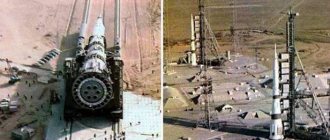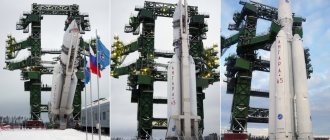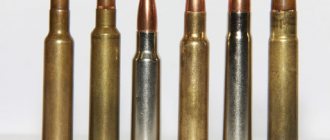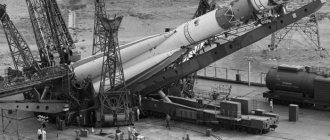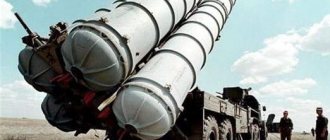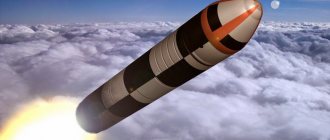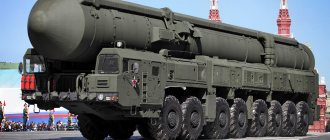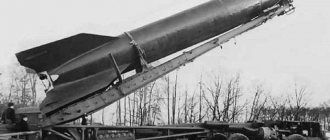"Energia" is a Soviet super-heavy launch vehicle. It was one of the three most powerful rockets ever built in its class, the Saturn V, as well as the ill-fated N-1 rocket which it was intended to replace. The rocket's other main purpose was to launch the Soviet reusable spacecraft into orbit, which distinguished it from the American one, which took off using its own engines powered by a large external fuel tank. Although Energia went into space twice in 1987-1988, there were no more launches after that, despite the fact that in the Soviet Union it was supposed to become the main means of delivering cargo into orbit in the 21st century.
Lunar bridgehead
After Valentin Glushko headed TsKBEM (formerly OKB-1), replacing the disgraced Vasily Mishin, he worked for 20 months on the creation of a lunar base based on a modification of the Proton rocket designed by Vladimir Chelomey, which used Glushko’s self-igniting engines.
By early 1976, however, the Soviet leadership decided to stop the lunar program and focus on the Soviet reusable spacecraft, since the American shuttle was seen as a military threat from the United States. Although Buran would ultimately look very similar to its competitor, Glushko made one significant change that allowed him to maintain his lunar program.
Soviet shuttle
In the American Space Shuttle, two solid rocket boosters accelerated the ship to an altitude of 46 km for two minutes. After their separation, the ship used engines located in its stern. In other words, the shuttle, at least in part, had its own rocket launcher, and the large external fuel tank to which it was attached was not a rocket. It was only intended to transport fuel for the main engines of a reusable spacecraft.
Glushko decided to build the Buran without any engines at all. It was a glider designed to return to Earth, which was launched into orbit by engines that looked like the fuel tank of the American shuttle. In fact, it was the Energia launch vehicle. In other words, the Soviet Union's chief designer hid a Saturn V-class upper stage in the reusable spacecraft's system, which could potentially become the basis for his beloved lunar base.
Third generation
What is the Energia launch vehicle? Its development began when Glushko headed the TsKBM (in fact, the name “Energia” was used in the name of the recently reorganized NPO department long before the creation of the rocket) and brought with him a new design of a rocket-propelled aircraft (RLA). At the beginning of the 1970s, the Soviet Union had at least three missiles - modifications N-1–R-7, Cyclone and Proton. All of them were structurally different from each other, so the cost of their maintenance was relatively high. For the third generation of Soviet spacecraft, it was necessary to create light, medium, heavy and super-heavy launch vehicles consisting of one common set of components, and the Glushko RLA was suitable for this role.
The RLA series was inferior to the Zenits of the Yangel Design Bureau, but this bureau did not have heavy launch vehicles, which made it possible for Energia to advance. Glushko took his RLA-135 design, which consisted of a large main upper stage and detachable boosters, and proposed it again along with a modular version of the Zenit as boosters and the main new rocket developed in his bureau. The proposal was accepted and the Energia launch vehicle was born.
5:05 / 07/02/17 Soviet super-heavy launch vehicle Energia
"Energy" (GRAU index - 11K25)
- Soviet super-heavy launch vehicle developed by NPO Energia. The most powerful of the Soviet launch vehicles and one of the most powerful in the world, along with the Saturn 5, N-1 and Space Shuttle.
The launch vehicle was an integral part of the Soviet reusable transport space system (MTKS) Energia-Buran, but, unlike the similar American MTKS Space Shuttle, it could be used autonomously to deliver cargo of large masses and dimensions to near-Earth space, to the Moon, planets of the solar system, as well as for manned flights, its creation was associated with Soviet plans for widespread industrial and military space exploration. [1]
Model of the Energia launch vehicle with the Buran spacecraft / Photo: ru.wikipedia.org
It is made according to a two-stage package design with a lateral arrangement of four blocks of the first stage around the central block of the second stage. For the first time in the USSR, cryogenic fuel was used (hydrogen in the second stage). The payload is mounted on the side surface of the second stage. The design features are the block-modular layout principle, which makes it possible, based on the blocks of the first and second stages, to create medium and heavy class carriers with a payload capacity of 10 to 200 tons. In connection with plans to use “Energia” for manned flights on a rocket, various methods were used to increase reliability and survivability and safety, such as 3- and 4-fold redundancy of important systems and the possibility of controlled flight if one of the engines fails on any part of the trajectory.
Development
It was created as a universal promising rocket to perform various tasks:
- carrier for MTKK "Buran"[2]
- carrier to support manned and unmanned expeditions to the Moon and Mars
- for launching new generation orbital stations
- for launching super-heavy geostationary satellite platforms
- for launching heavy military cargo
Work on the Energia-Buran program began in 1976, immediately after the closure of the N-1 program. [3] The main developer of the rocket was NPO Energia near Moscow (“Public Box B-2572 Enterprise”), production was carried out at Kuibyshev. The main developer of the control system is the Kharkov NPO Elektropribor.
Transportation of missile system elements on a special transport aircraft VM-T Atlant / Photo: fishki.net
The rocket blocks were delivered on a special VM-T transport aircraft [3] from the Bezymyanka airfield to the Baikonur cosmodrome (to the Yubileiny airfield), where in the assembly and testing building (MIC) at site 112 (branch - "Enterprise mailbox R- 6514"), the rocket was assembled and prepared for launch.
Only two launches of this unique complex were carried out:
- May 15, 1987 with an experimental load: the Polyus satellite (mass-size model Skif-DM, prototype of an orbital laser platform), not launched into orbit due to a failure of the orientation system of the spacecraft itself
- November 5, 1988 as part of the Buran MTKK complex
A large number of representatives of various rocket and space enterprises of the USSR and military units were involved in the launches of the complex.
At the launch of the Energia launch vehicle with the Polyus load (Skif-DM mockup) / Photo: Buran.ru
At the launch of the Energia launch vehicle as part of the Buran MTSC complex / Photo: Ukr-prom.com
The development of the Skif laser combat station, designed to destroy low-orbit space objects with an on-board laser complex, began at NPO Energia, but due to the heavy workload of the NPO, since 1981 the “Skif” topic for creating a laser combat station was transferred to OKB-23 ( KB "Salyut") (General Director D.A. Polukhin). This spacecraft with an onboard laser complex, which was created at NPO Astrophysics, had a length of approx. 40 m and weight 95 tons. To launch the Skif spacecraft, it was proposed to use the Energia launch vehicle.
Payload - Polyus spacecraft / Photo: Buran.ru
August 18, 1983 General Secretary of the CPSU Central Committee Yu.V. Andropov made a statement that the USSR unilaterally stopped testing the PKO complex - after which all tests were stopped. However, with the arrival of M.S. Gorbachev and the announcement of the SDI program in the United States, work on anti-space defense was continued. To test the laser combat station, a dynamic analog "Skif-D" was designed, approx. 25 m and a diameter of 4 m, in terms of external dimensions it was similar to the future battle station. "Skif-D" was made of thick sheet steel, the internal bulkheads added weight and added weight. There is emptiness inside the model. According to the flight program, it was supposed to splash down together with the second stage of Energia in the Pacific Ocean.
Subsequently, to carry out a test launch of the Energia launch vehicle, a prototype of the Skif-DM station (Polyus) with a length of 37 m, a diameter of 4.1 m and a weight of 80 tons was urgently created.
Closing the program
In the early 1990s, work on the Energia-Buran program was suspended. By the time the program was finally closed (1993), at least five Energia launch vehicles were in various stages of readiness at the Baikonur cosmodrome. Two of them, unfilled, were stored at the Baikonur Cosmodrome until 2002 and were the property of Kazakhstan; were destroyed on May 12, 2002 when the roof of the installation and testing building on site 112 collapsed. Three were at various stages of construction on the slipways of NPO Energia (now RSC Energia), but after the closure of the work the backlog was destroyed, the already manufactured rocket bodies either cut up or thrown into the backyard of the enterprise, where they continue to remain to this day.
Despite the cessation of operation of this carrier, the technologies developed for Energia are still in use today: the RD-170 engine of the Energia side blocks, the most powerful liquid engine in the history of astronautics, is used (under the designation RD-171) in the first stage the Zenit launch vehicle (including in the Sea Launch project), and the two-chamber RD-180 engine (actually the “half” of the RD-171), designed on the basis of the RD-171, is used in the American Atlas-5 rocket. The smallest version, the single-chamber RD-191, is used in the new promising Russian Angara rocket.
On the twentieth anniversary of the first launch, May 15, 2007, the media voiced the opinion that, given the funds and groundwork of the modern Russian space industry, it would take 5-6 years to revive Energia.
On August 20, 2012, RSC Energia announced its desire to participate in the tender for the development of a heavy-duty launch vehicle, which could take 5-7 years. However, RSC Energia did not submit an application to participate in the tender; it was won by the Russian Khrunichev Center.
In August 2016, information appeared in the media that the Roscosmos state corporation had begun designing a new super-heavy rocket, which was planned to be created using the backlog of the Energia-Buran program, in particular, RD-171 engines.
"Energia" is a Soviet super-heavy launch vehicle. It was one of the three most powerful rockets ever built in its class, the Saturn V, as well as the ill-fated N-1 rocket which it was intended to replace. The rocket's other main purpose was to launch the Soviet reusable spacecraft into orbit, which distinguished it from the American one, which took off using its own engines powered by a large external fuel tank. Although Energia went into space twice in 1987-1988, there were no more launches after that, despite the fact that in the Soviet Union it was supposed to become the main means of delivering cargo into orbit in the 21st century. [5]
Diagram of the Energia launch vehicle with payload / Image: a402-bgtu.narod.ru
Diagram of the Energia launch vehicle with the Buran spacecraft / Image: a402-bgtu.narod.ru
Lunar bridgehead
After Valentin Glushko [6] headed TsKBEM (formerly OKB-1), replacing the disgraced Vasily Mishin, he worked for 20 months on the creation of a lunar base based on a modification of the Proton rocket designed by Vladimir Chelomey, which used Glushko’s self-igniting engines .
Academician Valentin Glushko / Photo: rusplt.ru
Curriculum Vitae
Valentin Petrovich Glushko
(Ukrainian Valentin Petrovich Glushko; August 20 (September 2) 1908, Odessa - January 10, 1989, Moscow) - Soviet engineer and scientist in the field of rocket and space technology. One of the pioneers of rocket and space technology, the founder of Soviet liquid-propellant rocket engine construction. Chief designer of space systems (since 1974), general designer of the reusable rocket and space complex "Energia - Buran", academician of the USSR Academy of Sciences (1958; corresponding member since 1953), laureate of the Lenin Prize, twice laureate of the USSR State Prize, twice Hero of Socialist Labor ( 1956, 1961). Member of the CPSU Central Committee (1976-1989).
By early 1976, however, the Soviet leadership decided to stop the lunar program and focus on the Soviet reusable spacecraft, since the American shuttle was seen as a military threat from the United States. Although Buran would ultimately be very similar to its competitor, V. Glushko made one significant change that allowed him to maintain his lunar program.
Launch vehicle "Energia" and MTSC "Buran" / Photo: fb.ru
Soviet shuttle
In the American Space Shuttle, two solid rocket boosters accelerated the ship to an altitude of 46 km for two minutes. After their separation, the ship used engines located in its stern. In other words, the shuttle, at least in part, had its own rocket launcher, and the large external fuel tank to which it was attached was not a rocket. It was only intended to transport fuel for the main engines of a reusable spacecraft.
V. Glushko decided to build the Buran without any engines at all. It was a glider designed to return to Earth, which was launched into orbit by engines that looked like the fuel tank of the American shuttle. In fact, it was the Energia launch vehicle. In other words, the Soviet Union's chief designer hid a Saturn V-class upper stage in the reusable spacecraft's system, which could potentially become the basis for his beloved lunar base.
"Buran" and "Shuttle": such different twins / Image: topwar.ru
Third generation
What is the Energia launch vehicle? Its development began when Glushko headed the TsKBM (in fact, the name “Energia” was used in the name of the recently reorganized NPO department long before the creation of the rocket) and brought with him a new design of a rocket-propelled aircraft (RLA). At the beginning of the 1970s, the Soviet Union had at least three missiles - modifications N-1, R-7, Cyclone and Proton. All of them were structurally different from each other, so the cost of their maintenance was relatively high. For the third generation of Soviet spacecraft, it was necessary to create light, medium, heavy and super-heavy launch vehicles, consisting of one common set of components, and V. Glushko’s RLA was suitable for this role.
The RLA series was inferior to the Zenits of the Yangel Design Bureau, but this bureau did not have heavy launch vehicles, which made it possible for Energia to advance. Glushko took his RLA-135 design, which consisted of a large main upper stage and detachable boosters, and proposed it again along with a modular version of the Zenit as boosters and the main new rocket developed in his bureau. The proposal was accepted and the Energia launch vehicle was born.
Korolev was right
But V. Glushko had to take another blow to his pride. For many years, the Soviet space program was stalled because he disagreed with Sergei Korolev, who believed that liquid oxygen and hydrogen were the best fuels for a large rocket. Therefore, the N-1 had engines built by the much less experienced designer Nikolai Kuznetsov, while Glushko focused on nitric acid and dimethylhydrazine.
Although this fuel had the advantages of density and storability, it was less energy-dense and more toxic, which posed a big problem in the event of an accident. In addition, the Soviet leadership was interested in catching up with the United States - the USSR did not have large liquid oxygen and hydrogen engines, while the second and third stages of the Saturn V used them, as did the main engine of the Space shuttle". Partly voluntarily, partly because of this political pressure, but Glushko had to give in in his dispute with Korolev, who had been dead for eight years.
Heavy launch vehicles / Image: fb.ru
10 years of development
Over the next ten years (that's a long time, but not too long: the Saturn V took seven years to develop), NPO Energia developed a massive core stage. The side boosters were relatively lighter, smaller and used liquid oxygen and kerosene engines, which the USSR had extensive experience in creating, so the entire rocket was ready for its first flight in October 1986.
Design On June 15, 1988, the world's most powerful launch vehicle, Energia, was successfully launched into space from the Baikonur Cosmodrome. It was developed in the Podlipkinsky design bureau of the same name under the leadership of General Designer V. Glushko. The energy could launch a payload weighing 100 tons into space - 2 railway cars! And, although, according to the decision of the USSR Government, it was intended to launch our Buran reusable spacecraft into orbit, this rocket was universal and could be used for flights to the Moon and other planets.
The rocket is made according to a two-stage package design based on the second stage, in which 4 oxygen-hydrogen propulsion engines RD-0120 are installed. The first stage consists of four side blocks “A” with one oxygen-kerosene four-chamber engine RD-170 in each. Blocks “A” are unified with the first stage of the Zenit medium-class launch vehicle. The engines of both stages have a closed cycle with afterburning of exhaust turbine gas in the main combustion chamber. The payload of the launch vehicle (orbital ship or transport container) is mounted asymmetrically on the side surface of the central block using power communication units.
The rocket is assembled at the cosmodrome, transported, installed on the launch pad and launched using the transitional launch-docking block “I”, which is a power structure providing mechanical, pneumohydraulic and electrical connections with the launch device. The use of block Y made it possible to dock the rocket with the launch complex in difficult weather conditions when exposed to wind, rain, snow and dust. In the pre-launch position, the block is the lower plate on which the rocket rests with the surfaces of blocks A of the 1st stage; it also protects the rocket from the effects of rocket engine flows during launch. Block I remains at the launch complex after the rocket launch and can be reused.
To realize the service life of the RD-170 engines, designed for 10 flights, a system was provided for the return and reuse of first-stage A blocks. The system consisted of parachutes, a soft-landing turbojet engine and shock-absorbing struts, which were placed in special containers on the surface of blocks A, but during the design work it turned out that the proposed scheme was overly complex, insufficiently reliable and associated with a number of unresolved technical problems. By the start of flight tests, the return system had not been implemented, although the flight copies of the rocket had containers for parachutes and landing struts in which the measuring equipment was located. The central block is equipped with 4 oxygen-hydrogen engines RD-0120 and is the supporting structure. Lateral fastening of cargo and accelerators is used.
The operation of the first stage engines began from the launch and, in the case of two completed flights, was completed until the first escape velocity was reached. In other words, in practice, “Energia” was not a two-, but a three-stage rocket, since the second stage, at the moment of completion of work, gave the payload only a suborbital speed (6 km/s), and additional acceleration was carried out either by an additional upper stage (essentially, a third rocket stage), or its own payload engines - as in the case of the Buran: its integrated propulsion system (ODU) helped it, after separation from the carrier, achieve its first escape velocity.
The launch weight of "Energia" is about 2400 tons. The rocket (in the version with 4 side blocks) is capable of launching about 100 tons of payload into orbit - 5 times more than the operating Proton launch vehicle. Also possible, but not tested, are layout options with two (Energia-M), six and eight (Vulcan) side blocks, the latter with a record carrying capacity of up to 200 tons.
Designed options
In addition to the basic version of the rocket, 3 main modifications were designed, designed to launch payloads of various masses.
Energia-M "Energia-M" (product 217GK "Neutron")
[7] was the smallest rocket in the family, with a payload capacity reduced by approximately 3 times relative to the Energia launch vehicle, that is, with a payload capacity of 30-35 tons in LEO.
"Energia-M" (product 217GK "Neutron") / Image: topwar.ru
The number of side blocks was reduced from 4 to 2; instead of 4 RD-0120 engines, only one was installed on the central block. In 1989-1991 underwent comprehensive testing and was planned to launch in 1994. However, in 1993, Energia-M lost the state competition (tender) for the creation of a new heavy launch vehicle; According to the results of the competition, preference was given to the Angara launch vehicle (the first launch took place on July 9, 2014). A full-size mock-up of the rocket, with all its components, was stored at Baikonur.
Energy II (Hurricane)
Energy II (also called Hurricane) [8] was designed to be completely reusable. Unlike the basic modification of Energia, which was partially reusable (like the American Space Shuttle), the Uragan design made it possible to return all elements of the Energia - Buran system, similar to the Space Shuttle concept.
"Energy II" (also called "Hurricane") / Image: ribalych.ru
had to enter the atmosphere, glide and land at a regular airfield. Vulcan (Hercules)
The most severe modification:
its launch mass was 4747 tons. Using 8 side blocks and as the last stage, the Vulcan rocket [9] (by the way, this name coincided with the name of another Soviet heavy rocket, the development of which was canceled several years earlier) or Hercules "(which coincides with the design name of the heavy launch vehicle RN-1) was supposed to launch up to 175-200 tons into low Earth orbit.
Modification of the Energia rocket, Vulcan launch vehicle (Hercules) / Photo: www.kulch.spb.ru
Image: www.kulch.spb.ru
With the help of this colossal rocket, it was planned to carry out the most ambitious projects: settling the Moon, building space cities, manned flight to Mars, etc.
Assessment of the project by Dmitry Ilyich Kozlov, Soviet and Russian designer of rocket and space technology
.
Dmitry Kozlov twice Hero of Socialist Labor, general designer of the Central Specialized Design Bureau (TSSKB-Progress), corresponding member of the Russian Academy of Sciences (1991; corresponding member of the USSR Academy of Sciences since 1984)
Dmitry Kozlov / Photo: www.warheroes.ru
The words of Dmitry Kozlov regarding the Energia-Buran project:
“A few months after V.P. Glushko was appointed to the place of chief designer, NPO Energia, which he headed, was entrusted with the design of a new powerful launch vehicle, and the order for The ministry handed over its production to Kuibyshevsky.
Soon after this, Glushko and I had a long and very difficult conversation about ways of further development of the Soviet rocket and space industry, about the prospects for the work of the Kuibyshev branch No. 3, as well as about the Energia-Buran complex. I then suggested to him that instead of this project, he continue work on the N1 rocket. Glushko insisted on creating a new powerful carrier “from scratch,” and called N1 the yesterday of cosmonautics, no longer needed by anyone. He and I did not come to a common opinion then. As a result, we decided that the enterprise I headed and NPO Energia were no longer on the road, since we disagreed on the strategic line of development of the domestic cosmonautics. This decision of ours found understanding at the very top of the then government of the country, and soon branch No. 3 was removed from the subordination of NPO Energia and transformed into an independent enterprise. Since July 30, 1974, it has been called the Central Specialized Design Bureau (TSSKB). As you know, the Energia-Buran project was nevertheless implemented in the 80s, and this again required large financial costs from the country. That is why the Ministry of General Mechanical Engineering of the USSR, whose structure included our enterprise, was forced to repeatedly withdraw from the budgets and TsSKB a considerable part of the funds previously allocated to us. Therefore, a number of TsSKB projects were not completed in full due to underfunding, and some of them are not implemented at all. The Energia rocket took off for the first time with a size and weight model on board (the Polyus object), and the second time - with the Buran reusable spacecraft. Not a single more Energia launch was made, and primarily for a rather prosaic reason: at present there are simply no objects in outer space that would require flights (by the way, very expensive) of this huge rocket with a payload capacity of over 100 tons to service. » Interesting Facts
- Two black “checkers” on board the rocket are laser telemetry and correction points. The pre-launch preparation of the Energia launch vehicle with the Buran launch vehicle was stopped approximately 50 seconds before the launch; the APT command ("emergency launch abort") was issued due to abnormal departure of the aiming board (under the black checkers). In the magazine “Technology for Youth” dedicated to the launch, the cover showed “Energy” in flight with the aiming board undocked.
- Since the design of the rocket did not have sufficient strength to transport empty tanks in a horizontal position, in all cases of such transportation, including air transport, the tanks were under pressure. The transport aircraft also had a pressurization system installed.
- At the same time, the strength characteristics of the rocket and its control system made it possible to launch the Buran spacecraft in stormy conditions. At the time of launch, the surface wind speed was 20 m/sec, and at an altitude of 20 km it was at least 50 m/sec.
- As of 2012, the Energia launch vehicle is the only Soviet and Russian rocket and space system that could fundamentally use liquid hydrogen as fuel at all stages of launching a payload into low-Earth orbit.
Image: www.kulch.spb.ru
Tactical and technical indicators
| General information | |
| A country | USSR |
| Index | 11K25 |
| Purpose | launch vehicle |
| Developer | NPO "Energia" |
| Manufacturer | |
| Main characteristics | |
| Number of steps | 2 |
| Length, m | 59 |
| Diameter (maximum), m | 16 |
| Launch weight, t | 2 400 |
| Payload weight: | |
| at NOO, t: | Energy: 100 (design); Vulcan: 200 (design) |
| on GSO, t | Energy: 18 (design) |
| Launch history | |
| State | the program is closed |
| Number of starts | 2 |
| successful | 2 |
| First start | May 15, 1987 |
| Last run | November 15, 1988 |
| steps | |
| Accelerator (Stage 0) | A (11С771) |
| Number of accelerators, pcs. | 4 |
| Main engine | RD-170 |
| Traction. Ts (MN) | 740 → 806,2 (7,55 → 7,89) |
| Specific impulse. With | 309,5 → 337,2 |
| Operating time, s | 140 |
| Flammable | kerosene |
| Oxidizer | oxygen |
| First stage | C |
| Main engines | 4 × RD-0120 |
| Traction. Ts (MN) | 591 → 760 (5,8 → 7,5) |
| Specific impulse. sec | 353,2 → 455 |
| Working hours. sec | 480 |
| Flammable | algae |
| Oxidizer | oxygen |
When writing the material, data from open Internet sources was used:
1. Materials from the Wikipedia website - the free encyclopedia, publication “Energy (launch rocket)”.
2. Materials from the website of the publication “ACADEMIC”, publication “MTKK “Buran” is:”.
3. Stanislav Zakaryan, article “Rocket N-1 - “Tsar Rocket””, news agency “WEAPONS OF RUSSIA”, April 25, 2022.
4. Materials from the site publication “Military Review” article “Skif” - combat laser station.”
5. Material from the site FB.ru, publication “Soviet super-heavy launch vehicle Energia.”
6. Materials from the Wikipedia website - a free encyclopedia, publication “Glushko, Valentin Petrovich”.
7. Materials from the publication “Military Review” article “Energy of Triumph”.
8. Materials from the website of the publication Rikabu, article “Reusable transport system “Energia-Hurricane””.
9. Materials from the website of the publication Pikabu, article “Super-heavy carrier “Vulcan””.
Source: IA “ARMS OF RUSSIA”, Stanislav Zakaryan 1
Tags: “Energy”. GRAU index, 11K25, Soviet super-heavy launch vehicle, development, NPO Energia, Saturn-5, N-1, Space Shuttle, component, MTKS Energia-Buran
Korolev was right
But Glushko had to take another blow to his pride. For many years, the Soviet space program was stalled because he disagreed with Sergei Korolev, who believed that liquid oxygen and hydrogen were the best fuels for a large rocket. Therefore, the N-1 had engines built by the much less experienced designer Nikolai Kuznetsov, while Glushko focused on nitric acid and dimethylhydrazine.
Although this fuel had the advantages of density and storability, it was less energy-dense and more toxic, which posed a big problem in the event of an accident. In addition, the Soviet leadership was interested in catching up with the United States - the USSR did not have large liquid oxygen and hydrogen engines, while the second and third stages of the Saturn V used them, as did the main engine of the Space shuttle". Partly voluntarily, partly because of this political pressure, but Glushko had to give in in his dispute with Korolev, who had been dead for eight years.
"Pole" of the arms race
Between the fall of 1985 and the fall of 1986, a new payload, Polyus, was created. This was one of Vladimir Chelomey’s functional cargo blocks, repurposed from a space station module and closely connected to the ISS Zarya module. Polyus was intended to conduct a wide range of experiments, but its main task was to test the 1-MW carbon dioxide laser, a weapon that had been developed in the USSR since 1983. In reality, things were not as sinister as they seemed, since the USSR was criticizing the US for the strategic defense initiative, and Mikhail Gorbachev did not want to risk the Americans finding out about the military confrontation. The Reykjavik summit ended in October 1986 and the countries were close to a radical reduction in nuclear weapons, and in December 1987 they were going to conclude an agreement on the reduction of intermediate-range missiles. Various components of the laser were deliberately not used, only the ability to track targets remained, and even that Gorbachev forbade testing when he visited Baikonur a few days before the launch. However, Gorbachev’s visit led to the appearance of a formal name for the rocket (as opposed to the proposed shuttle): the inscription “Energy” appeared on its body shortly before the Secretary General’s arrival.
Program error
The first launch of the Energia launch vehicle took place on May 15, 1987. During the first few seconds of the flight, before the ship left the launch pad, it tilted noticeably, but then corrected its position after the rocket's attitude control system was launched. After this, the Energia flew beautifully, accompanied by a single MiG, and quickly disappeared into the low clouds. The boosters separated correctly (although for this and the next flight they were not equipped with parachutes that would allow them to be reused), and then the core stage left visual range. After burning out, the launch vehicle separated from the Polyus and, as planned, fell into the Pacific Ocean.
Polyus weighed 80 tons and had to fire its own rocket engine to reach orbit. To do this, it was necessary to rotate 180 degrees, but due to a program error after launch, the module continued to rotate, and, instead of moving to a higher orbit, it sank lower. The cargo module also crashed in the Pacific Ocean.
Launches
Despite the enormous labor involved in its creation, as well as problems associated with transportation, in the end only two rocket launches were carried out.
The first took place on May 15, 1987. By this time, scientists and engineers had conducted more than six thousand tests of various rocket mechanisms; only 5 full-size copies were created. The launch took place at Baikonur. “Energy” showed itself simply admirably, completing all the tasks assigned to it and acting strictly according to schedule. But the cargo itself being launched into orbit - the Polyus satellite (which is also an interesting specimen - according to some sources, it was an 80-ton prototype of a combat space laser), during separation from the second stage, could not reach the required altitude due to failure in the computer system.
The second flight occurred on November 15, 1988. Now “Energy” fulfilled its direct purpose, for which it was originally created. On its “hump” was the reusable spacecraft “Buran”, an advanced machine of that time. This was his first and only spacewalk. Both the launch vehicle and the spacecraft itself showed their best side, each completing its mission in full.
Success?
Although the launch failed, the rocket itself was a complete success. Work on Buran continued, and the mostly completed shuttle (ready to fly, but capable of generating enough power for only one day in orbit) was coupled with a second rocket to launch an uncrewed mission on November 15, 1988. Once again, the Energia launch vehicle was launched flawlessly (with a change in the software that prevented a dangerous tilt during launch), and this time its payload did not disappoint either: Buran automatically landed at Baikonur, completing two orbits around the Earth, three hours and twenty-five minutes later.
Thus, by the beginning of 1989, the Soviet Union had the most powerful missile, so far unsurpassed by anyone. It could launch a shuttle with a payload similar to that of American orbiters, and itself could launch 88 tons of cargo into low-Earth orbit or deliver 32 tons to the Moon (compared to 118 tons and 45 tons for the Saturn V and 92. 7 tons and 23.5 tons for N-1). It was planned to further increase this figure to 100 tons, and work was underway to create a special cargo compartment instead of the adapted “Polyus”. A smaller version of the rocket, called Energia-M, with one engine and two boosters, was also in the final stages of development, and was capable of launching a payload weighing up to 34 tons.
Creation
Its uniqueness lay in its unprecedented multitasking and flexibility in use. In addition to the fact that, according to the plan, it was supposed to launch the Buran spacecraft into the upper layers of the atmosphere, it could also independently deliver payloads into orbit. Depending on their configuration, the mass of these cargoes varied from 30 to 200 tons.
Was the rocket project successful?
NOT REALLY
The rocket itself could reach a mass of 2400 tons, and the total power of all engines, in the maximum version, was about 170 million horsepower! They also planned to use the rocket in the exploration of not the Moon, but Mars and Venus, and in the future the rest of the planets of the Solar System. Grandiose plans that, if successful, would allow us to become the first power in the world to colonize other planets!
NPO “Energia” named after S.P. Queen
The implementation of the project, as mentioned above, started in 1976. The development was carried out by NPO “Energia” named after S.P. Queen. Specifically, the production of the rocket and its components in the workshops was entrusted to the Kuibyshev Technical Plant, and the control system and computer filling was taken over by the Kharkov Elektropribor, an advanced scientific enterprise at that time.
Expert opinion
Kobelman David Borisovich
Soviet and Russian scientist, specialist in the field of astrophysics and physics of gravitational systems. Professor, Hero of Socialist Labor, Lenin Prize laureate.
The first components of “Energia” were ready already in the 80th year. They were sent to Zhukovsky, a center of aviation and space technology, by waterway. There was an incident that almost cost millions of rubles and the heads of several officials.
On one of the rivers, sea cargo had to pass under a railway bridge. The clearance between the elements of “Energy” and the bridge itself was just over half a meter! To avoid such troubles, they began to develop a special cargo aircraft VM-T. The tests were carried out in the years 82-83, and in the absence of a better option, the remaining parts of the rocket were transported in the same way, but now with strict consideration of the height of the transported cargo.
In 1984, the VM-T was finally tested and began to be used in practice. Now transporting “Energy” was much easier and faster, and did not cost gray hairs. She was delivered directly from Kuibyshev to Baikonur. There, at site number 112, specially built for this purpose, the arriving parts were assembled and preparations were made for launch. Subsequently, the VM-T was replaced by the An-225, the pearl of the Soviet aircraft industry.
Expensive pleasure
The collapse of the Soviet Union was the main reason for the failure of the project. He was just beginning to find his feet, but the need to protect the security interests of a superpower disappeared, as did the money needed for large-scale scientific missions. Another problem was that the Zenit boosters were manufactured by a company located in independent Ukraine.
True, even before that the Energia launch vehicle had become little in demand - if there was no need to fly to the Moon, then lifting 100 tons of cargo into orbit was unnecessary. The shuttle, for which it was primarily developed, had the same shortcomings as the American shuttles, but the rocket did not have the advantage of a monopoly position, as it had in the United States before the Challenger explosion in 1986.
Options [edit]
| This section requires additional links for verification . |
The Energia II (Hurricane) rocket was planned to be completely reusable and could land at a regular airfield.
Three main design options were conceptualized after the initial configuration, each with a completely different payload.
Energy M[edit]
Energia M was an early 1990s configuration and was the smallest of the three. The number of Zenit boosters was reduced from four to two, and instead of four RD-0120 engines, there was to be only one in the core. It was designed to replace the Proton rocket, but lost the 1993 Angara competition. [18] [ link required
]
Energy II (Hurricane) [edit]
"Energy II", called " Hurricane"
(Russian: Uragan,
hurricane
), was a rocket proposed in the late 1980s [19] as fully reusable with the ability to land at a conventional airfield. Unlike Energia-Buran, which was intended to be semi-reusable (like the US Space Shuttle), the Uragan concept was intended to allow all Buran/Energia elements to be fully recovered, just like the original, fully reusable orbiter/booster concept. US Shuttle. [20] The Energia II core was proposed to be capable of re-entry and glide.
Vulcan-Hercules [edit]
Last unbuilt design concept [ when?
] was also the largest.
With eight Zenit launch vehicles and an Energia-M core as the upper stage, Vulcan (the name of another Soviet super-heavy rocket that was canceled a few years earlier) or Hercules (the same name as for the N-1 Rocket [ citation needed
]) it was originally intended to be launched into orbit weighing up to 175 tons.
In 1990–1993 The Vulcan launch vehicle was being developed and the Energia launch pad was being reconstructed for its launches. But later work on this project was curtailed due to lack of funds and the collapse of the Soviet Union. [21]
Cry of despair
NPO Energia's desperation can be seen in its proposed missions:
- Putting massive lasers into orbit to restore the ozone layer over several decades.
- Building a base on the Moon to extract helium-3, used in fusion reactors being developed by an international consortium, which will be ready by 2050.
- Launching spent nuclear fuel into “repositories” in heliocentric orbit.
Eventually it came down to the question of what the rocket could do that smaller, cheaper spacecraft could not do - each Energia launch cost $240 million, even with the inflated ruble-dollar exchange rate in the late 1980s. If launches were carried out only when necessary, maintaining a missile factory would be a luxury that neither the Soviet Union nor Russia could afford.
Pyrrhic victory
If we agree with the theory that the Soviet Union collapsed primarily due to financial difficulties, then we can also reasonably say that Energia-Buran was one of the main reasons for this collapse. This project was an example of uncontrollable expenses that destroyed the USSR, and the condition for its continued existence was to refrain from implementing such projects.
On the other hand, one can reasonably argue that the greatest damage to the superpower was caused by Mikhail Gorbachev’s reaction to the country’s financial situation, and the USSR could have survived to this day if the Politburo had been headed by someone else, following Konstantin Chernenko.
Possible prospects
Leaving aside the fantastic ideas mentioned above, "Energia" could be used to launch into orbit one or several large modules of the space station, which would then be completed by modules launched using the "Energia-Buran" combination: at the end of 1991, the station " Mir-2" was reconstructed to use 30-ton modules.
It was also possible to build a smaller shuttle, which would be located not on the side, but in the front of the rocket.
Glushko's bet that the Soviet space program, as had happened before, would go through an era of change turned out to be correct. Although it is more efficient to design spacecraft and launch vehicles for a specific mission, history shows that once they are created, new uses arise. Glushko died on January 10, 1989, less than two months after Energia's second and final flight.
Links[edit]
- ^ abcdef Energy Characteristics
- ^ abcd Launch vehicle "Energia" Official website
- Krivonosov, Khartron: Computers for missile guidance systems
- Control systems for intercontinental ballistic missiles and launch vehicles. Archived February 5, 2010, at the Wayback Machine.
- Russian space network, Energy page. Accessed September 21, 2010
- ^ abcd Bart Hendricks; Bert Vis (2007). Energia-Buran: Soviet spacecraft. Springer Science & Business Media. ISBN 978-0-387-73984-7.
- ^ abcd B. Hendricks, "The Origin and Evolution of the Energy Family of Rocket Rocket", J. British Interplanetary Soc., Vol.
55, pp. 242-278 (2002). - ^ a b Lukashevich, Vadim. "The history of the creation of the Energia launch vehicle". buran.ru
(in Russian). Retrieved January 25, 2022. - ↑
Lukashevich, Vadim.
"Spaceship Polyus". buran.ru
(in Russian). Retrieved January 25, 2022. - ↑
Day, Dwayne A.; Kennedy, Robert G. III (January 2010). "Soviet Star Wars: The Launch That Saved the World from Orbital Laser Battle Stations". Air and Space/Smithsonian Institution. Retrieved January 25, 2022. - ↑
Lukashevich, Vadim.
"Chronology of Buran's flight on November 15, 1988" . buran.ru
(in Russian). Retrieved January 25, 2022. - Vassili Petrovich, Polyus (accessed September 21, 2010)
- "Pole". Astronautix
. Retrieved September 25, 2022. - ↑
Mark Wade,
Encyclopedia Astronautics,
Buran Archived
December
, 2008 at the Wayback Machine (accessed September 21, 2010) - Angara's "first rocket" was "launched on a suborbital test flight." Spaceflight now
. July 9, 2014. Retrieved July 9, 2014. - Roscosmos will create a new super-heavy rocket. Izvestia
. August 22, 2016 - ↑
Zak, Anatoly.
"New Russian missile project could resurrect Soviet-era colossus". Popular Mechanics
. Hearst Digital Media. Retrieved October 24, 2022. - "This Huge Russian Missile Was Abandoned for Decades". Popular Mechanics
. 2015-07-06. Retrieved May 28, 2022. - https://www.buran.ru/htm/41-3.htm
- "Space Shuttle - NASA Technical Report Server (NTRS)" (PDF). nasa.gov
. 2011 - Godwin, Robert (2006). Russian spaceship
. Space Pocket Reference Guides. Apogee Books. p. 59. ISBN 1-894959-39-6.
"Zenith" of glory
To this day, Energia has no successors. The Zenits, used as its boosters, are the cheapest launch vehicles in the world ($2500–3600 per kilogram). In 2010, NPO Energia bought a stake in the Sea Launch consortium and is now responsible for launches from the ocean platform, as well as from the Baikonur Cosmodrome in Kazakhstan.
The RD-170 engine, developed for Zenit and Energia, also turned out to be one of the best rocket engines. Its modifications can be boasted by the South Korean Naro-1, the Russian Angara launch vehicle and the American Atlas V, which was not only used to carry out scientific tasks, such as delivering the Curiosity rover and launching the New Horizons probe to Pluto , but also by the American military. That's the difference between 1988 and today.
Cost of engines for the Yenisei super-heavy rocket
Before moving on to the comparison and relevance of the Energia and Yenisei rockets, it is worth clarifying the cost of the engines. In modern market conditions, the price of a ready-made solution greatly influences the feasibility of the project. Especially if just one of the components already costs many millions of dollars. As an example, I will add the price of other rocket engines so that the trend in the development of the space industry is clear.
- RD-107 (according to 2011 - dollar exchange rate is 35 rubles) - 30 million rubles The kerosene rocket engine created for the R-7 intercontinental rocket (the first in the world) was used on all side blocks of the first stage of Soyuz launch vehicles.
- Merlin (Falcon 9) - approximately $1.5 million per engine. The first stage of the Falcon Heavy rocket requires 9 of these engines and the total cost will be $13 million.
- RD 170 (Zenit-2 rocket) - $14 million (as of 2014) For the two-stage Zenit rocket, one RD-171M engine is used, in fact it is the old RD-170 under a new name - supposedly progress and innovation! In 2014, Yuzhmash Design Bureau was unable to agree on the supply of engines from Russia. Zenit does not fly, the Lybid satellite has not been launched, the finished engines are on the balance sheet of the Federal State Unitary Enterprise “Center for Operation of Ground-Based Space Infrastructure”. Now we know the current cost of one RD 170 for the Energia rocket! Four rocket engines of this type were installed on the super-heavy rocket.
- RD-180 - 13 million dollars (1/2 of the RD-170 rocket engine) Since 1999, RD-180 rocket engines have been used on American Atlas-3 (6 launches) and Atlas-5 (12 launches) rockets
According to Energomash director Vladimir Solntsev, rocket engines were sold in the USA at a loss! The exchange rate and production costs have changed greatly, and previously concluded agreements have not been revised. These data were confirmed by the Accounts Chamber during the audit of Energomash. The first strange situation with Energomash
- RD-191 (analogous to RD-181) - $7.5 million in 2013 (1/4 RD 170 engine) (calculated at the exchange rate of $33) Used on the Angara A5 rocket, the first stage requires 5 RD 191 rocket engines. The total cost of the first stage alone will be: $37.5 million.
A unique situation has arisen with the production of RD-191 for the Angara rocket. In order to reduce the cost of production, the Khrunichev plant is forced to establish the process of creating a rocket engine for the Angara rocket in its own production. The second strange situation with Energomash!
At the end of the 80s, the RD-170 engine was the most powerful rocket engine created by mankind, its thrust was 20 million liters. With. Relatively low weight, the use of a closed fuel combustion cycle, high pressure in the combustion chambers and the use of cheap kerosene and oxygen allowed the RD-170 to show not only outstanding traction characteristics, but excellent fuel economy indicators. As of 2010, no analogues to this engine have appeared and various modifications of the RD-170 are still in use today. Even on the future super-heavy rocket Yenisei it is planned to use the RD-171MV modification, and its launch is only planned in 2028. And everything seems to be fine, but the final cost of producing engines for the RD-170 modifications is so high that it jeopardizes the development of every space project in the current economic realities. And if for the USSR in the late 80s there was simply no other solution, the country needed a super-heavy rocket! The launch of Buran, which required a powerful rocket, was planned; there were other tasks for the use of exclusively super-heavy rockets: a base on the Moon, a new version of the MIR station, a flight to Mars. Modern conditions, it seems to me, require a slightly different solution. It is very important to create a cost-effective first stage system. It is important to compete with other developers in the world and not give up position, being in the trend of the development vector of the space industry! If we use Soviet developments and add to them modern systems for lowering side blocks, then this system will allow us to develop a universal platform. Here's how SpaceX automatically releases the first stage blocks:
Video of the landing of the first stage of the Falcon 9 rocket:
We should also not forget that the world’s first reusable launch vehicle was supposed to be the Energia-2 project. Many have not heard about the existence of this project, but in the meantime, already on the Energia-Buran project, some elements of the future reusable rocket were laid down. For example: parachute rescue system! Read more about the Energia-2 project in a separate article - The world's first reusable launch vehicle Energia-2 (article under writing).
